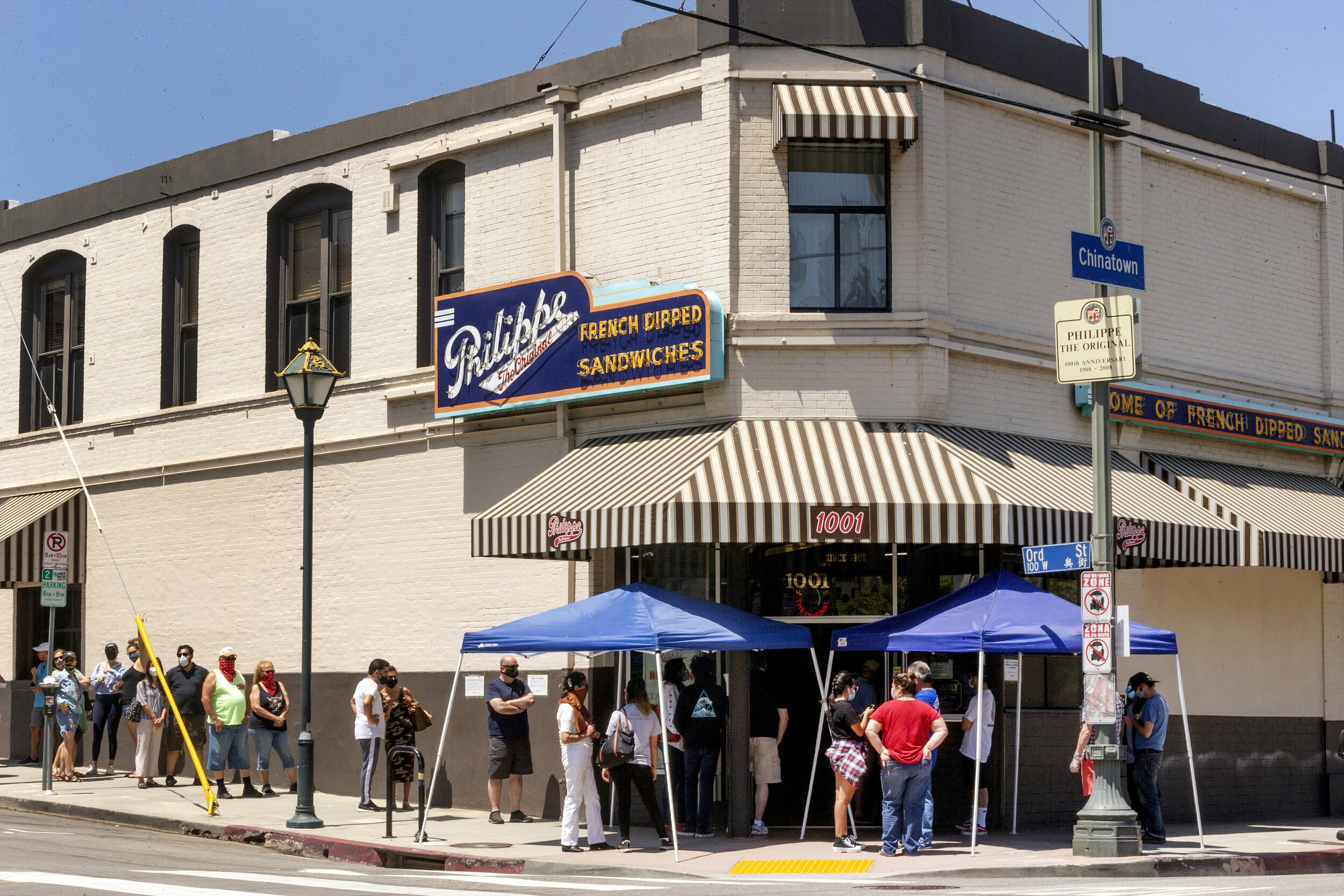In this Saturday, May 2, 2020 file photo people stand in line while following social distancing guidelines as they wait for French dip sandwiches outside Philippe the Original restaurant in downtown Los Angeles. California restaurants have drafted recommendations to allow the industry to reopen for sit-down dining but with an array of safeguards, but would avoid setting percentage limits on occupancy or screening the temperature of patrons coming through the door. (AP Photo/Damian Dovarganes,File)
Salad bars, buffets and shared bread baskets are out
By MICHAEL R. BLOOD Associated Press
For Marc Simon, the president of Rubio’s Coastal Grill, the challenge for restaurants amid the coronavirus crisis is not just reopening their doors, it’s rebuilding trust with customers.
“If we don’t do that — we don’t rebuild confidence — this way back is going to be much longer than any of us would like and many of us can afford,” he told Gov. Gavin Newsom Thursday during an online forum.
“The way to do that … is to ensure the safety and the well-being of our team members and our guests. For us it starts and stops there,” he said.
Simon’s assessment came as the state prepares to release guidelines next week to gradually reopen California restaurant dining rooms, shuttered since mid-March to deter the spread of the virus.
It’s likely to be a disjointed process, with restaurants in rural areas opening first, and eateries in Los Angeles, San Francisco and other urban areas that have been hot spots for infections remaining closed longer.
“Not every part of the state will be able to do that right away,” Newsom said during the forum, acknowledging that there would be different timelines around the state.
Late last week, Newsom announced restaurants in certain counties could begin opening within a week or two, but with restrictions. No specific dates were set, and counties must first meet a set of benchmarks that show the spread of the virus is in check.
It wasn’t clear what counties could meet that threshold or how soon.
California restaurants have drafted a plan to allow the industry to reopen for sit-down dining with an array of safeguards, while avoiding possible requirements imposed in other states that customers have their temperature taken or the number of tables be dramatically limited.
The recommendations were submitted to Newsom on Thursday. They envision a changed world within dining rooms, as an industry built on face-to-face contact and crowded tables looks for ways to safely conduct business and avoid the spread of coronavirus.
According to the proposal, tables would be limited to no more than 10 people. Salad bars, buffets and shared bread baskets would be out. Salt and pepper shakers could be replaced by bottles of hand sanitizer. And meals could arrive from food servers sheathed in face masks.
Restaurant dining rooms were shuttered in California in March as part of broad orders to deter the spread of the virus, though takeout and delivery remained. The move devastated the industry and sent droves into unemployment lines in a state with an internationally known food culture.
The recommendations drafted by the California Restaurant Association, in partnership with the California Conference of Local Health Officers and the California Conference of Directors of Environmental Health, will give Newsom a potential framework for reopening dining rooms as he begins to ease lockdown orders this week for retail shops, bookstores, florists and sporting goods businesses.
The association wants Newsom to set only broad guidelines in four areas — employee health, social distancing, public education and improved sanitation and disinfection.
Cities and counties would be left to determine the rules within each category, because what makes sense in San Diego might not in Eureka or Bakersfield.
For example, the recommendations urge local governments to consider such measures as requiring temperature checks for restaurant employees, requiring mandatory hand-washing schedules for workers and face coverings for employees who interact with the public.
In the area of social distancing, local jurisdictions will need to establish specific measures for keeping tables apart or setting up barriers between them, and limiting tables to no more than 10 people.
For most people, the new coronavirus causes mild or moderate symptoms, such as fever and cough that clear up in two to three weeks. For some, especially older adults and people with existing health problems, it can cause more severe illness, including pneumonia, and death. The vast majority of people recover.
In Florida this week, restaurants in all but three South Florida counties were allowed to reopen their inside dining rooms at 25% capacity. The California restaurants are seeking to avoid an across-the-board percentage limit on how many people could be inside, instead allowing local officials to account for differences in restaurant designs and layouts.
“The risk is different in every county,” association CEO Jot Condie said.
Newsom raised the issue briefly Thursday during an online forum with restaurant industry workers. But he gave no indication whether state health officials intended to set across-the-board limits on occupancy.
For restaurants, the return to business would mean a dramatic shift from what customers have taken for granted.
Condie predicted that diners would not only accept the changes, but “I think they are going to come to expect it.”
In some reopened eateries around the country, restaurants are checking customers’ temperatures, a possible indicator of infection. The California restaurants are recommending local governments consider requiring temperature checks — but only for employees.
Nothing would prevent a county from requiring customer temperature checks, but Condie said “policing guests” was ultimately left off the recommendations. Part of the concern for restaurants centered on liability: Customers who believe they were wrongly turned away could file a lawsuit.
A small number of communities around the state have allowed restaurants to reopen in advance of state guidelines.

